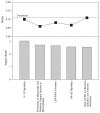Gene expression changes in multiple sclerosis relapse suggest activation of T and non-T cells
- PMID: 20882258
- PMCID: PMC3022990
- DOI: 10.2119/molmed.2010.00071
Gene expression changes in multiple sclerosis relapse suggest activation of T and non-T cells
Abstract
A defining feature of multiple sclerosis (MS) is the occurrence of clinical relapses separated by periods of clinical stability. Better understanding of the events underlying clinical relapse might suggest new approaches to treatment. The objective of this study was to measure changes in the expression of RNA in the blood during relapse. We used microarrays to measure mRNA expression in paired samples from 14 MS patients during clinical relapse and while stable. Seventy-one transcripts changed expression at the P < 0.001 significance level. The most notable finding was decreased expression of transcripts with regulatory function, expressed primarily in non-T cells. These decreased transcripts included the interleukin-1 receptor antagonist, which had a corresponding decrease in the protein concentration in serum. Transcripts with increased expression were expressed primarily in T cells. Pathways analysis suggested involvement of the cytokine network, coagulation and complement cascades, IL-10 signaling and NF-κB signaling. We conclude that there are alterations of mRNA expression in both T cells and non-T cells during MS relapse.
Figures



Similar articles
-
Molecular network analysis of T-cell transcriptome suggests aberrant regulation of gene expression by NF-kappaB as a biomarker for relapse of multiple sclerosis.Dis Markers. 2008;25(1):27-35. doi: 10.1155/2008/824640. Dis Markers. 2008. PMID: 18776589 Free PMC article.
-
Impaired expression of peripheral blood apoptotic-related gene transcripts in acute multiple sclerosis relapse.Ann N Y Acad Sci. 2007 Jun;1107:155-67. doi: 10.1196/annals.1381.017. Ann N Y Acad Sci. 2007. PMID: 17804543
-
Gene expression profiling in multiple sclerosis: a disease of the central nervous system, but with relapses triggered in the periphery?Neurobiol Dis. 2010 Mar;37(3):613-21. doi: 10.1016/j.nbd.2009.11.014. Epub 2009 Nov 26. Neurobiol Dis. 2010. PMID: 19944761
-
Glutamate, T cells and multiple sclerosis.J Neural Transm (Vienna). 2017 Jul;124(7):775-798. doi: 10.1007/s00702-016-1661-z. Epub 2017 Feb 24. J Neural Transm (Vienna). 2017. PMID: 28236206 Review.
-
Peripheral blood gene expression signature mirrors central nervous system disease: the model of multiple sclerosis.Autoimmun Rev. 2006 Oct;5(8):517-22. doi: 10.1016/j.autrev.2006.02.009. Epub 2006 Mar 23. Autoimmun Rev. 2006. PMID: 17027885 Review.
Cited by
-
Quantitative proteomics and multi-omics analysis identifies potential biomarkers and the underlying pathological molecular networks in Chinese patients with multiple sclerosis.BMC Neurol. 2024 Oct 31;24(1):423. doi: 10.1186/s12883-024-03926-3. BMC Neurol. 2024. PMID: 39478468 Free PMC article.
-
Immune and Epstein-Barr virus gene expression in cerebrospinal fluid and peripheral blood mononuclear cells from patients with relapsing-remitting multiple sclerosis.J Neuroinflammation. 2015 Jul 14;12:132. doi: 10.1186/s12974-015-0353-1. J Neuroinflammation. 2015. PMID: 26169064 Free PMC article.
-
Nuclear Factor κB (NF-κB)-Mediated Inflammation in Multiple Sclerosis.Front Immunol. 2020 Mar 24;11:391. doi: 10.3389/fimmu.2020.00391. eCollection 2020. Front Immunol. 2020. PMID: 32265906 Free PMC article. Review.
-
Methylglyoxal-Derived Advanced Glycation Endproducts Accumulate in Multiple Sclerosis Lesions.Front Immunol. 2019 Apr 24;10:855. doi: 10.3389/fimmu.2019.00855. eCollection 2019. Front Immunol. 2019. PMID: 31068938 Free PMC article.
-
Changes in expression profiles of internal jugular vein wall and plasma protein levels in multiple sclerosis.Mol Med. 2018 Aug 9;24(1):42. doi: 10.1186/s10020-018-0043-4. Mol Med. 2018. PMID: 30134823 Free PMC article.
References
-
- Noseworthy JH, Lucchinetti C, Rodriguez M, Weinshenker BG. Multiple sclerosis. N Engl J Med. 2000;343:938–52. - PubMed
-
- Buljevac D, et al. Prospective study on the relationship between infections and multiple sclerosis exacerbations. Brain. 2002;125:952–60. - PubMed
-
- Polman CH, et al. A randomized, placebo-controlled trial of natalizumab for relapsing multiple sclerosis. N Engl J Med. 2006;354:899–910. - PubMed
-
- Achiron A, Gurevich M, Friedman N, Kaminski N, Mandel M. Blood transcriptional signatures of multiple sclerosis: unique gene expression of disease activity. Ann Neurol. 2004;55:410–7. - PubMed
Publication types
MeSH terms
Associated data
- Actions
LinkOut - more resources
Full Text Sources
Medical
Molecular Biology Databases

